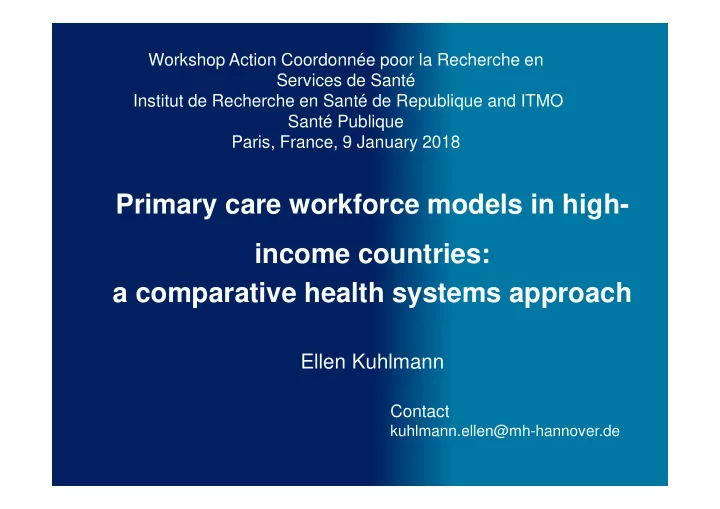

Workshop Action Coordonnée poor la Recherche en Services de Santé Institut de Recherche en Santé de Republique and ITMO Santé Publique Paris, France, 9 January 2018 Primary care workforce models in high- income countries: a comparative health systems approach Ellen Kuhlmann Contact kuhlmann.ellen@mh-hannover.de
Background ‚Primary care in the driving seat ‘ (WHO) is a widely shared policy goal to respond more effectively to demographic change and growing multi-morbidity. However: health systems show high variation in primary care models and workforces. Why?
Aims Identify institutional conditions of health systems for effective and sustainable models of primary care workforces Methods • Cross-country comparison; eight high-income countries: Australia, England/UK, Germany, Netherlands, New Zealand, Japan, Sweden, USA. • Indicators: connection of primary care models with health workforce patterns; the type of integration (GP-led vs. multiprofessional centres) and the role of nurses and integrated teams (weak – strong). • Data: policy documents, public statistics, mainly OECD data, and other relevant secondary sources
Basic quantitative indicators Numbers of practising generalist and specialist doctors per 1,000 inhabitants Generalist doctors Specialist doctors 2007 2015* 2007 2015* Australia 1.51 1.53 1.43 1.61 Germany 1.48 1.69 2.01 2.35 Japan n/a n/a n/a n/a Netherlands 1.2 1.46 1.6 1.86 New Zealand 0.79 0.91 1.25 1.29 Sweden 0.62 0.65 2.02 2.16 United Kingdom 0.73 0.8 1.75 1.97 United States 0.3 0.31 2.13 2.25 n/a = not available. Source: Blank et al., 2017, chapter 5
Basic quantitative indicators Density of doctors and nurses (practising) Country Medical + Nurses Doctors per nurses per nursing practit. 1,000 1,000 per per 1,000 population population doctor population Australia 14.9 3.40 11.52 3.4 17.0 4.04 12.96 3.2 Germany 12.8 2.29 10.54 (2012) 4.6 Japan Netherlands 14.4 3.30 11.08 (2012) 3.7 New Zealand 12.9 2.83 10.07 3.6 15.3 4.12 11.15 (2012) 2.8 Sweden 11.0 2.77 8.18 3.0 UK 11.1 1 11.1 2.56 4.3 US Source: Blank et al., 2017, chapter 5
A model of integrated primary care policy indicators Model of integration Level of integration across primary health within medical model care organizations under the leadership of across health care doctors sectors across different across policy sectors professional groups Source: Blank et al., 2017, chapter 5
Model of integration Level of integration Australia • Integration in a GP- • Some integration and led model of PH with improved coordination strong organizational across providers and change and multi- sectors, inclusion of disciplinary teams; preventive services and • integration of public health; • high variety and lack of professional groups with new roles of comprehensive nurses coordination
Model of integration Level of integration • Integration within • Integration across PHC England / UK* medical model organizations by predominant with merging GP practices focus on GP-led PHC; into PHC trusts; • some integration • some integration across across professional health care and policy groups with a focus on sectors, as primary care nurses and new roles trusts have commissioning responsibility for public health and collaboration with social care
Model of integration Level of integration Germany • Integration within • Integration across PHC medical model with organizations to better focus on medial connect generalist and leadership and specialist doctors; • some integration and organizational restructuring; improved coordination • limited integration but fragmentation of care across professional sectors and weak public groups, especially for health • fragmented coordination nurses, but few regional pilots aim at with different social shifting tasks from insurance schemes doctors to medical assistants
Model of integration Level of integration • Some integration • Integration between Japan within a medial medical providers to model with some connect specialised organizational PHC and hospital integration with physicians and do; hospitals; • lack of coordination • lack of professional between sectors and integration policy fields
Model of Level of integration integration • Integration within • Integration and Netherlands a medical model coordination across with strong sectors with strong organizational public health and change and patient involvement; • little coordination of multidisciplinary teams; policy and fragmented • integration across leadership professions with new roles of nurses
Model of integration Level of integration • Integration in a multi- • Some integration New Zealand professional provider across providers and model with strong sectors; organizational • little coordinated change and large centres; leadership • integration across professions with new roles of nurses
Model of integration Level of integration Sweden • Multi-professional • Integration and teams with strong coordination between public responsibility organizations, sectors, and some and policy fields organizational through local change; authorities; • integration of • coordination of professional groups leadership with some with strong role of variety through nurses privatisation
Model of integration Level of integration • Multi-professional • Little integration USA provider model, between medical although GP- providers, sectors, and leadership is strong, policy areas; and improved • no coordinated organizational integration; leadership • integration across profession with new roles of nurses
Simplified model: a matrix of professional and organisational dimensions of primary care workforce integration Weak nursing integration Japan Germany Multi-prof. GP-led centres England, New Zealand integration Australia, Sweden The Netherlands USA Strong nursing integration
Conclusions High variation and country-specific patters, but only to some degree system-based differences. Health system characteristics do not explain variety of primary care workforce policy and practices.
Conclusions Primary care policy has largely failed to fully transform the workforce. Yet without workforce change and new competencies, people-centred effective primary care is not possible.
Which way forward? There is an urgent need for health system typologies that include human resources for health as major category (e.g. Wendt et al.)
Which way forward? Greater attention to health policy implementation and the policy levers for primary care workforce change.
Acknowledgement: thanks to Viola Burau and Robert Blank
European Public Health Association new section Health Workforce Research (HWR); https://eupha.org/health-workforce-research You are welcome to join. Please sign up via the website, it is free of charge; 11 th EUPHA Conference, Ljubljana, 28 November – 1 December 2018
Recommend
More recommend